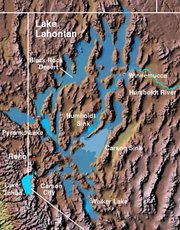Prehistoric: Difference between revisions
No edit summary |
added prehistoric items from www.timelinesdb.com |
||
| Line 14: | Line 14: | ||
The existence of the lake coincided roughly with the first appearance of humans in that region of North America. Archaeological evidence exists along the ancient lake shore of early human habitation. | The existence of the lake coincided roughly with the first appearance of humans in that region of North America. Archaeological evidence exists along the ancient lake shore of early human habitation. | ||
---- | |||
http://www.timelinesdb.com/listevents.php?subjid=246&date1=-99999999999&date2=99999999999&words=&fromrec=0&dayinhist=&title=Nevada www.timelinesdb.com/listevents.php?subjid=246&...&title=Nevada | |||
230Mil BC | |||
The Panthalassa Ocean covered much of what later became the western United States. Sediments later called the Luning Formation were deposited in what later became the mountain ranges of central Nevada. Fossil ichthyosaurs included Shonisaurus popularis. | |||
225Mil BC | |||
Icthyosaur fossils first found in 1928 by prof. Seimon W. Muller of Stanford 150 miles SE of Reno, dated to this time. An inland sea linked to the Pacific and submerged California and Nevada during the Triassic. | |||
180Mil BC - 135Mil BC | |||
Along the western coastal area of North America it seems likely that for part of the time there was a long, narrow island running parallel to the edge of the continent from Alaska to Mexico. Dinosaurs and marine reptiles have left their bones in this region. The Nevadan orogeny was now under way. | |||
145Mil BC | |||
The seas over Nevada receded. | |||
112Mil BC - 99Mil BC | |||
Most of Nevada was a flood plain and supported dinosaurs including the raptor dromaesaur, sauropods, tyrannosauroids and iguanodonts. | |||
---- | |||
Latest revision as of 00:46, 12 December 2007

Ancient Lake Lahontan was a large endorheic lake that existed during the ice age, covering much of northwestern Nevada, extending into northeastern California and southern Oregon. At its peak approximately 12,700 years ago (during a period known as the "Sehoo Highstand"), the lake had a surface area of over 8500 square miles, Nevada Division of State Parks: Lahontan State Recreation Area with its largest component centered at the location of the present Carson Sink. The depth of the lake was approximately 900 feetWalker Lake Interpretive Association History (290 m) at present day Pyramid Lake, and 500 feet (150 meters) at the Black Rock Desert. Lake Lahontan, during this earlier ice age, would have been one of the largest lakes in North America.Nevada Division of State Parks: Lahontan State Recreation Area Lake Lahontan Yacht Club
Climate change around the end of the Pleistocene epoch led to a gradual desiccation of ancient Lake Lahontan. The lake had largely disappeared in its extended form by approximately 9,000 years ago. As the surface elevation dropped, the lake broke up into series of smaller lakes, most of which rapidly dried up leaving only a playa. These playas include the Black Rock Desert, the Carson Sink and theHumboldt Sink. The only modern day remnants existing as true lakes are Pyramid Lake and Walker Lake. Winnemucca Lake has been dry since the 1930s and Honey Lake periodically desiccates. The ancient shoreline is evidenced by tufa formations throughout the area.
Surprisingly, the watershed feeding Lake Lahontan is not thought to have been significantly wetter during its highstand than it is currently. Rather, its desiccation is thought to be mostly due to increase in the evaporation rate as the climate warmed. Recent computer simulations (using the DSSAM Model C.M.Hogan,Marc Papineau et al. Development of a dynamic water quality simulation model for the Truckee River, Earth Metrics Inc., Environmental Protection Agency Technology Series, Washington D.C. (1987)and other techniques) indicate that if precipitation and evaporation rates within the watershed were maintained at their historical yearly maximum and minimum, respectively and if diversions of the Truckee River ceased, the Ice Age extent of Lake Lahontan could return.
The existence of the lake coincided roughly with the first appearance of humans in that region of North America. Archaeological evidence exists along the ancient lake shore of early human habitation.
http://www.timelinesdb.com/listevents.php?subjid=246&date1=-99999999999&date2=99999999999&words=&fromrec=0&dayinhist=&title=Nevada www.timelinesdb.com/listevents.php?subjid=246&...&title=Nevada
230Mil BC
The Panthalassa Ocean covered much of what later became the western United States. Sediments later called the Luning Formation were deposited in what later became the mountain ranges of central Nevada. Fossil ichthyosaurs included Shonisaurus popularis.
225Mil BC
Icthyosaur fossils first found in 1928 by prof. Seimon W. Muller of Stanford 150 miles SE of Reno, dated to this time. An inland sea linked to the Pacific and submerged California and Nevada during the Triassic.
180Mil BC - 135Mil BC
Along the western coastal area of North America it seems likely that for part of the time there was a long, narrow island running parallel to the edge of the continent from Alaska to Mexico. Dinosaurs and marine reptiles have left their bones in this region. The Nevadan orogeny was now under way.
145Mil BC
The seas over Nevada receded.
112Mil BC - 99Mil BC
Most of Nevada was a flood plain and supported dinosaurs including the raptor dromaesaur, sauropods, tyrannosauroids and iguanodonts.